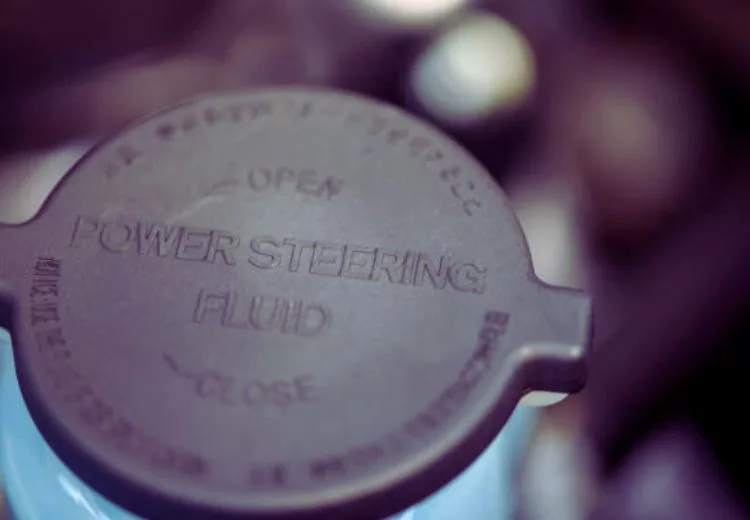Your car’s power steering system is vital for smooth and safe driving. It helps you navigate tight corners and make sudden manoeuvres. However, power steering fluid leaks can be a significant threat to your car’s performance, causing expensive repairs and even accidents.
In this comprehensive guide on IchieTech, we will discuss the common symptoms, causes, and preventive measures for power steering fluid leaks. By understanding the key signs and causes of these leaks, you can take both DIY and professional repair options to keep your car road-ready. IchieTech has got you covered.
Signs of a Power Steering Fluid Leak
Identifying the signs of a power steering fluid leak at an early stage is crucial to prevent further damage and costly repairs. Common symptoms of such a fluid leak include fluid spots on the ground, strange noises, and stiffness in the steering wheel.
It is particularly beneficial to check for any power steering leaks when your car has been parked for a while, especially when you start it for the first time each day. Ignoring these signs may lead to impaired handling and steering, thereby increasing the risk of accidents.
Additionally, power steering leaks could be detrimental to the environment, potentially contaminating air, water, and soil.
1. Fluid Stains on the Ground
One of the most evident signals of a power steering fluid leak is the presence of pinkish or reddish droplets beneath your vehicle. These fluid patches typically appear as translucent or slightly red-tinted stains, indicating the leakage or accumulation of power steering fluid from your car. It’s imperative to promptly attend to this issue to prevent further damage and ensure the safe operation of your vehicle.
2. Unusual Noises
Power steering fluid leaks can generate a range of unusual sounds, including squeals, grinds, or whines when you turn the steering wheel. For instance, a squealing noise emanating from the steering pump upon starting your vehicle may be an indicator of a power steering fluid leak. It’s essential to have this examined without delay. Disregarding these warning sounds could lead to a potentially significant problem with your power steering system.
3. Stiffened Steering Wheel
Another unmistakable sign of a power steering fluid leak is a stiffened steering wheel. The diminished lubrication resulting from a fluid leak can make steering significantly more challenging, or even impossible, potentially elevating the risk of an accident. If you encounter difficulty manoeuvring your steering wheel due to stiffness, it’s critical to promptly seek the expertise of a qualified mechanic to address the issue and mitigate potential safety hazards.
Common Causes of Power Steering Fluid Leaks
It’s crucial to understand the root causes of power steering fluid leaks to prevent them effectively and make timely repairs. The most common culprits are damaged hoses, overfilled reservoirs, and the use of incorrect fluid types. Each of these causes can be detrimental to your power steering system, leading to leaks, impaired performance, and even accidents. Dealing with these issues early on can save you time, money, and the headache of dealing with more severe problems later.
1. Damaged Hoses
Cracks in the pressure or return hoses can cause power steering fluid leaks. These hoses carry hydraulic fluid between different parts of the power steering system. Over time, they can develop holes or get damaged, resulting in power steering fluid leaks and affecting your vehicle’s steering performance. Regularly check your power steering hose and connections for signs of wear or damage to prevent leaks and ensure your vehicle’s safe operation.
2. Overfilling the Reservoir
If you fill the power steering fluid reservoir beyond the recommended level, it can lead to:
- Blown seals and leaks.
- Fluid leakage.
- Foaming of the fluid.
- Potential damage to engine components.
- A messy engine compartment.
Additionally, it can cause problems like pump damage, overheating, and reduced performance. To prevent these issues and maintain your vehicle’s steering performance, regularly monitor the power steering fluid reservoir and keep it at the correct level.
3. Using the Wrong Fluid Type
Using the incorrect type of power steering fluid can result in significant vehicle damage and leaks. Different vehicles require specific power steering fluid types, and using the wrong one can accelerate wear and tear on power steering components, potentially causing leaks. Always refer to your vehicle’s owner’s manual and use the recommended power steering fluid to avoid system damage and leaks.
How to Inspect Your Power Steering System for Leaks
Detecting a power steering fluid leak early can save you from expensive repairs and potential accidents. To find the source of the leak, inspect the power steering pump, power steering rack, hoses, and connections. By thoroughly examining these parts, you can identify problems and take the necessary steps to fix them.
Regularly checking your power steering system not only helps you spot leaks but also ensures your vehicle’s overall health and performance. Let’s delve into how to inspect each component for leak signs.
1. Power Steering Pump
The power steering pump creates the hydraulic pressure needed for your vehicle’s steering. To check for a leaking power steering pump, visually examine the shaft for fluid seepage or loose/damaged components. If you see any issues, address them promptly to prevent further damage and maintain your vehicle’s steering performance.
2. Power Steering Rack
The power steering rack enables your vehicle’s wheels to turn. Continuous exposure to road grime and dirt can cause wear and tear on the shaft and seals, leading to power steering rack leaks. To inspect the power steering rack for signs of wear that may cause leaks, visually inspect it for leaks or signs of deterioration. If you detect any wear and tear, it’s crucial to replace the power steering rack.
3. Hoses and Connections
Hoses and connections play a crucial role in transporting hydraulic fluid between various power steering components. To check for leaks in hoses and connections, visually examine them for wear or damage signs. If you spot any issues, address them promptly to prevent further damage and ensure your vehicle’s safe operation. Regularly inspecting hoses and connections is a vital aspect of vehicle maintenance, and it can save you trouble down the road.
Options for Fixing Power Steering Fluid Leaks
When dealing with power steering fluid leaks, you can choose between two primary options: DIY repairs and professional repair services. DIY fixes are suitable for minor leaks and can involve tightening loose seals, applying Teflon tape to threads, or replacing the entire hose. However, more complicated problems may necessitate the expertise of a professional mechanic.
Both repair choices have their pros and cons. Let’s examine each one to help you decide what’s best for your vehicle.
1. DIY Repairs
For minor power steering fluid leaks, DIY repairs can be a cost-effective solution. Inexpensive additives like power steering stop leaks can help seal minor leaks and prevent further seepage. Moreover, if the issue is linked to a damaged hose or component, replacing it yourself can save you money on labour charges.
Nevertheless, it’s crucial to park your vehicle in a secure location and adhere to safety guidelines when attempting DIY repairs. Keep in mind that DIY fixes may not be suitable for more intricate problems, and you may need professional assistance.
2. Professional Repair Services
For complex power steering fluid leak issues, professional repair services are the most reliable choice to rectify a power steering system problem. A skilled mechanic can conduct a comprehensive examination of your power steering system, accurately diagnose the problem, and ensure that repairs are carried out correctly, guaranteeing the safety of your vehicle.
The cost of professional repair for a power steering fluid leak typically ranges from ₦50,000 – ₦100,000, although it may vary depending on the problem’s complexity and the price of replacement parts.
Preventing Power Steering Fluid Leaks
To avoid potential leaks and maintain your vehicle’s safe operation, adopt a proactive approach to power steering system maintenance. Regularly inspecting, using the right fluid, and addressing issues promptly are crucial steps in preventing power steering fluid leaks.
Here are some tips to help you keep your power steering system in excellent condition and prevent future leaks.
1. Regular Maintenance
Regular maintenance plays a critical role in preventing power steering fluid leaks and ensuring the overall health of your power steering system. By consistently examining your power steering pump, rack, hoses, and connections for signs of wear or damage, you can detect potential leaks early and resolve them before they lead to more significant problems. Additionally, routine maintenance saves you money by preventing costly repairs and potential accidents in the long run.
2. Using the Correct Fluid
Using the proper type of power steering fluid is vital for your vehicle’s power steering system to function correctly. Always refer to your vehicle’s owner’s manual and use the recommended power steering fluid to prevent system damage and leaks.
Furthermore, regularly check your power steering fluid level to ensure optimal steering system performance. Mixing old and new power steering fluid is acceptable as long as it’s the right type for your vehicle. Using the correct fluid extends your power steering system’s lifespan and helps prevent potential leaks.
3. Addressing Issues Early
Timely addressing any signs of a power steering fluid leak can prevent further damage and costly repairs. Pay close attention to unusual noises, stiffness in the steering wheel, or fluid spots on the ground to identify potential issues early and take necessary steps to rectify them. Regularly inspecting your power steering system and promptly addressing any concerns is essential to maintain your vehicle’s steering performance and on-road safety.
Conclusion
In conclusion, power steering fluid leaks can significantly impact your vehicle’s performance and safety. By recognizing leak signs, understanding common causes, and conducting regular power steering system inspections, you can prevent further damage and costly repairs. Taking a proactive approach to power steering system maintenance, using the correct fluid, and addressing issues promptly will ensure your vehicle operates safely and provides a smooth driving experience. Stay vigilant and keep your power steering system in top condition to enjoy confident driving on the open road.










